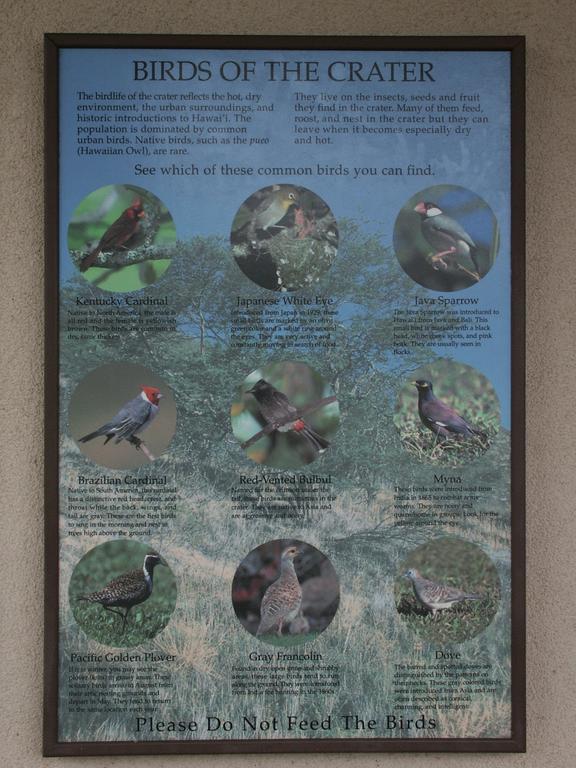The 4 C's |
Corey's home page |
Corey's photos |
Travel |
Trip to Hawaii |
Birds of the Crater
previous next
Birds of the Crater
From the text of the sign:
Birds of the Crater
The birdlife of the crater reflects the hot, dry environment, the urban
surroundings, and historic introductions to Hawai'i. The population is
dominated by common urban birds. Native birds, such as the pueo
(Hawaiian Owl), are rare.
They live on the insects, seeds, and fruit they find in the crater.
Many of them feed, roost, and nest in the crater but they can leave when
it becomes especially dry and hot.
See which of these common birds you can find.
- Kentucky Cardinal
- Native to North America, the male is all red and the female is
yellowish brown. These birds are common in dry, kiawe
thickets.
- Japanese White Eye
- Introduced from Japan in 1929, these small birds are marked by an
olive green color and a white ring around the eyes. They are very
active and constantly moving in search of food.
- Java Sparrow
- The Java Sparrow was introduced to Hawai'i from Java and Bali. This
small bird is marked with a black head, white cheek spots, and pink
beak. They are usually seen in flocks.
- Brazilian Cardinal
- Native to South America, this cardinal has a distinctive red head,
crest, and throat while the back, wings, and tail are gray. These
are the first birds to sing in the morning and nest in trees high
above the ground.
- Red-Vented Bulbul
- Named for the crimson under the tail, these birds are numerous in
the crater. They are native to Asia and are aggresive and noisy.
- Myna
- These birds were introducted from India in 1865 to combat army
worms. They are noisy and quarrelsome in groups. Look for the
yellow around the eyes.
- Pacific Golden Plover
- If it is winter, you may see the plover (kolea) in grassy
areas. These solitary birds arrive in August from their artic
nesting grounds and depart in May. They tend to return to the same
location each year.
- Gray Francolin
- Found in dry, open grass and shrubby areas, these large birds tend
to run along the ground. They were introducted from India for
hunting in the 1860s.
- Dove
- The barred and spotted doves are distinguished by the patterns on
their necks. These gray colored birds were introduced from Asia and
are often described as comical, charming, and intelligent.
Please Do Not Feed The Birds
(Click the image to view a larger version.)

Corin Anderson |
corin+www@the4cs.com
These pictures from: May 2002
